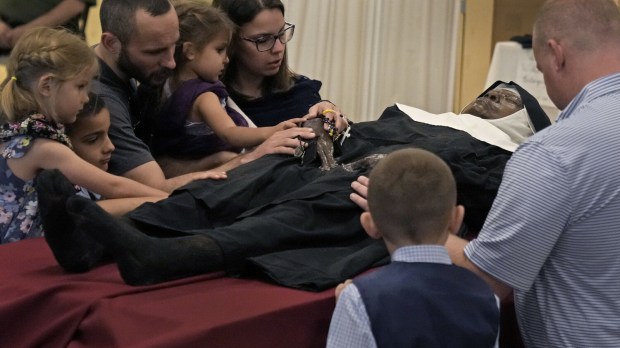Early on in “Gaudium et Spes,” the Pastoral Constitution on the Church in the Modern World, we read: “The Church has always had the duty of scrutinizing the signs of the times and of interpreting them in the light of the Gospel. Thus, in language intelligible to each generation, she can respond to the perennial questions which men ask about this present life and the life to come, and about the relationship of the one to the other.”
Two perennial questions that human beings cannot resist tend to go together: “Why is this happening and what does it all mean?” We ask them in repeated groanings in times of crisis, whether personal or experienced with the world. We ask it in whispered awe at moments of sublime, unfathomable joy.
We quite understandably ask them when confronted with a straight-up mystery — one of those unanswerable events that occur from time to time within the shared life of the Church.
The apparent incorruptibility of Sister Mary Wilhelmina Lancaster, the African American foundress of the Benedictines of Mary, Queen of Apostles, prompts these same questions.
For the uninitiated, the nuns of the Abbey of Our Lady of Ephesus, located in Gower, Missouri, recently exhumed the sister’s body — intending to inter her bones within a shrine to St. Joseph in their chapel — only to find the nun’s remains, and her habit, seemingly untouched by time or decay since her death four years earlier.
These things happen, of course, and the Church is always very quick to remind us that sometimes incorruptibility occurs due to conditions of a grave, or a coffin, or natural atmospheric conditions.
All very true. But sometimes incorruptibility is thought to occur because God wills that a holy life serves him in one final and unique way — by reminding us that while our home remains within God’s vast immensity of eternity, our material selves, loved into being, matter. Our matter matters.
Since the discovery of Sister Wilhelmina’s intact remains, four aspects of the story have many asking, “What is happening and what does it mean?” First, the condition of her body which, though buried in the moist earth, housed in a splintered wooden coffin that was heavily covered with moss, was found supple and undiminished.
Secondly, Sister Wilhelmina’s utterly intact habit, which remained pristine even though, as Abbess Cecilia Snell told OSV News, “the (cloth) lining of her coffin was gone.”
A third consideration is that the nuns of Ephesus abbey are what we might call “old school” Benedictines, meaning not only do they follow the Rule of St. Benedict regarding the hours of liturgical prayer, private prayer and “lectio divina,” the seasons of fasting (only one full meal a day throughout Lent), monastic self-sufficiency and the ongoing “conversion of life” so singular to Benedictines, but they do it while worshiping in the extraordinary form of the Mass, or pre-Vatican II ritual.
So, what is happening here, and what does it all mean?
Perhaps we will never know this side of eternity, but “Gaudium et Spes” encourages us to pay attention, and to freely wonder: “The People of God believes that it is led by the Lord’s Spirit … it labors to decipher authentic signs of God’s presence and purpose in the happenings, needs and desires in which this People has a part …”
Freely wondering then, I can’t help noticing a few signs amid the times:
— That while human beings are still arguing that abortion should be legal up to the time of a child’s birth; when some are arguing, shamefully, that “minor-attracted persons” should be legitimized; and when so many are treating their bodies like disposable goods or cheap carnival rides, we are being given a sign that yes, our matter matters.
— While Catholics debate about whether or not a religious habit has evangelical value or speaks at all to a life of radical love, this nun’s habit, though dirt covered, remains in pristine condition.
— While there is division within the church over the Latin Mass and the continuance of Pope Benedict’s “Summorum Pontificum,” these nuns use the 1962 monastic Office, with its traditional Gregorian chant, in Latin.
Finally, and this is a point few are making: While Black Catholics are seeking fuller representation within the Church while giving voice to their own passionate love for Christ and his body, all of these wonder-full “signs” we ponder have arisen from the grave of an African American nun, descended from enslaved people, who labored for old-school monasticism, and the habit, and the Latin, in the name of her Beloved.
As the initial hubbub over Sister Wilhelmina’s relics begins to subside, the community she founded is going about its business, contentedly growing year-by-year and already building a foundation. I have no idea what any of it means. But I do think we’re supposed to be wondering about it as if reading the signs and times, and talking about it, too.


